Drinking Water Protection
- Drinking Water Protection Home
- About Us
- A-Z Index of Contaminants in Water
- Community Public Water Supply
- Drinking Water Grants and Loans
- Drinking Water Institute
- Drinking Water in Schools and Child Cares
- Drinking Water Revolving Fund
- Laws and Rules
- Noncommunity Public Water Supply
- Source Water Protection
- Water Operator and Certification Training
- Drinking Water Protection Contacts
Related Topics
- Annual Reports
- Drinking Water Risk Communication Toolkit
- Drinking Water Protection External Resources
- Fact Sheets
- Forms
- Invisible Heroes Videos: Minnesota's Drinking Water Providers
- Noncom Notes Newsletter
- Sample Collection Procedures (videos, pictures, written instructions)
- Waterline Newsletter
Related Sites
- 10 States Standards
- Clean Water Fund
- Health Risk Assessment – Guidance Values and Standards for Water
- Minnesota Well Index
- Water and Health
- Wells and Borings
Environmental Health Division
Owatonna Survives 2010 Flood, Raises Wells to Head Off Future Floods
From the Spring 2012 Waterline
Quarterly Newsletter of the Minnesota Department of Health Public Water Supply Unit, Waterline
A complete list of feature stories can be found on the Waterline webpage.
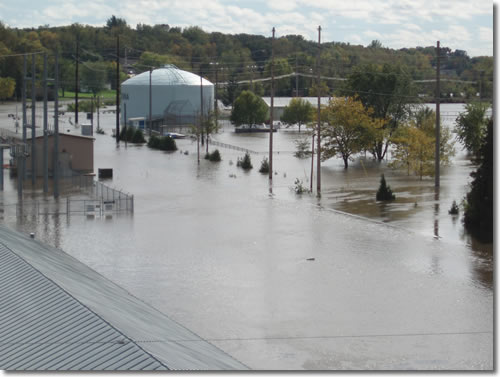 |
| Owatonna was among the communities in southeastern Minnesota that dealt with a flash flood in 2010. Earlier actions by the city helped save its wells. The city has taken more action to protect itself against future floods. |
Rain fell across much of southern Minnesota throughout the day on Thursday, September 24, 2010. Meanwhile, water superintendents and others from utilities were gathered in the northern part of the state, at the annual conference of the Minnesota Section of American Water Works Association in Duluth.
That evening, as the group gathered for the awards dinner, reports came in that the rain was falling harder and flooding many areas. The decision makers huddled and talked on their cell phones, finding out what was happening in their communities; those who didn’t have problems talked about what they could do to help those who were not so lucky.
Myron Volker of Owatonna learned his city was among the unlucky and was on its own. Because of prior wellhead protection planning he knew that a flood on the Straight River would threaten two of Owatonna Public Utilities’ (OPU) public water supply wells. Volker called his office with instructions to seal and caulk one of their wells if the water got high enough to come in. He returned the next morning and found only one route in, from the west. “We were an island,” he said, finding the city of 25,000, approximately 70 miles south of Minneapolis, split in two by the rising waters.
By the time the rain let up, about eight inches had come down over a two-day period near Owatonna and more in other areas. The rain in Owatonna followed a two-week period in which four inches had already fallen, leaving the ground saturated and unable to absorb more.
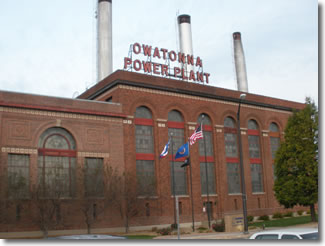 |
| Owatonna Public Utilities was flooded in September 2010. The water utility offices moved into unflooded portions of the power plant. |
The main offices of Owatonna Public Utilities and several critical pieces of their water supply infrastructure are near the center of town, next to the Straight River in an isolated low point. At the bottom of a bowl covering 450 acres, the area collects storm water and has experienced flooding in the past. Owatonna had escaped the brunt of an even larger storm three years before, one that knocked out a number of cities, but the August 2007 storm that decimated areas to the south caused the city to more seriously examine options to protect its water supply.
Owatonna has 10 wells, 5 of which are used regularly, and treats the water at a central pump station by adding chlorine, fluoride, and a polyphosphate to sequester iron and manganese. The wells, ranging in depth from 649 to 1,325 feet, draw from the Prairie Du Chien-Jordan and Mount Simon aquifers.
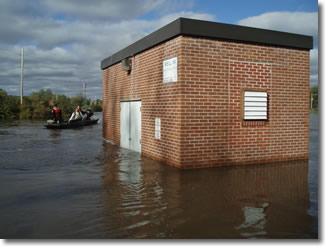 |
| Above: Well 4 survived the 2010 flood because its pump base had been raised earlier in the year. Below: With Well 4 out of danger, city crews and local volunteers were able to concentrate sand-bagging efforts on Well 2. |
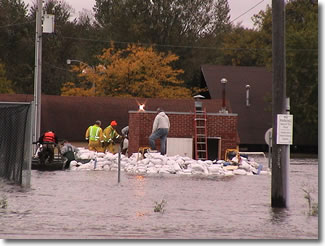 |
The utility called on its consulting firm, Barr Engineering of Edina, Minnesota, and went through its wellhead protection plan in determining possible actions after the 2007 floods.
“The wellhead protection planning process was successful,” said Brian LeMon of Barr Engineering. “It identified that Wells 2 and 4 were below the flood-plain level. We recommended a series of projects to get them up out of the flood plain. We had been working with them (OPU) for quite a few years, giving them different proposals and ideas of how to get them up out of the flood plain.”
From this planning came the decision to raise the pump base of Well 4 to a foot above the 100-year flood plain. “The building for Well 4 had a high ceiling, allowing for the pump base to be raised,” explained LeMon. That was one of the options. . . . They ran with it.”
The work was completed in the spring of 2010, a project that LeMon and OPU engineering director Ronnie Johnson said was fortunate. Johnson referred to the “luck that we had addressed Well 4 in the spring.”
“That was a true dodging of the bullet,” LeMon said of the raising of the pump base of Well 4, which allowed crews, along with citizen volunteers, to concentrate on saving Well 2 by sandbagging during the 2010 flood. “They probably wouldn’t have had time to sandbag both wells. At least the wellhead itself was up above the flood level.”
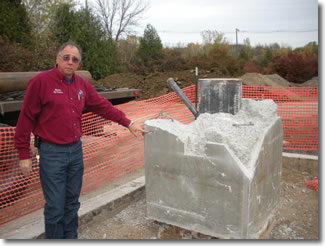 |
| Myron Volker points to the level the water rose on the pump base for Well 4. The pump base had been raised earlier in 2010. It has since been removed, and the ground level raised for both Wells 4 and 2. |
Volker described the situation as, “A lot of chaos,” as gas and electric services were turned off during the crisis. However, the water system survived and service continued. Well 3, located in the power plant adjacent to the water utility offices and the primary well field, was used as Wells 2 and 4 were shut down during the flooding.
Community involvement was a big factor in keeping Well 2 from being submerged, Volker said, noting that many people with flooded homes, rather than staying in shelters, came out to help with the sandbagging.
After getting the utility and city back to some degree of normalcy, OPU looked ahead again.
The 2007 floods that hit nearby areas had been enough of a wake-up call for Owatonna to realize it had to look at additional actions to protect the utility. Besides the raising of the Well 4 pump base, the city considered options ranging from ring dikes to levees to raising the wells.
“At that point, before the flood, they weren’t that concerned, but they were treating it seriously,” said LeMon. After the 2010 flood made a direct hit on the city, “Then the realization came, knowing we have to do something. After the flood, we sat down with them.”
Johnson looked at the Minnesota Recovery Flood Fund and then worked with the Minnesota Department of Natural Resources to receive matching funds to protect the wells, which were identified as critical infrastructure, by elevating them.
LeMon said the utility had already considered raising Well 2, “but it’s an older well and considerations had to be made about investing this much in an older well. Well 4 was a newer well, but since the well house was in better shape, they had to consider if it was worth it to have to build a new building.” Despite the concerns, the utility decided to raise both wells.
Work on the ground raising began in mid-October of 2011 for a four-month project that included demolishing the existing well houses, removing the existing wellheads, bringing in fill, and constructing new wellheads. The general contractor for the project was Rocon, Inc., of Owatonna, and the well work was performed by E. H. Renner & Sons of Elk River, Minnesota.
Wells 2 and 4 were raised 2 feet above the 100-year flood plain, and the ground around the wells will keep the flood waters 50 feet away from the well houses in almost all areas.
“They made good decisions,” said LeMon. “They were on-track. They were actively planning for those projects. When the disaster came, they were ready to make the necessary investments.”
“Every time you learn,” said Johnson. “We were prepared for what we had experienced in the past. . . . When it hits you once, you know you have to prepare for it again.”